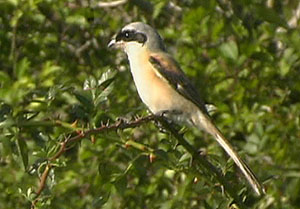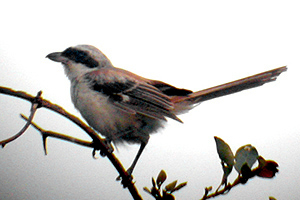Introduction:
The Long-tailed Shrike is a fairly common and widespread species, ranging east from the former Soviet Central Asia and the Indian subcontinent to central and southern China, and south to Taiwan, the Sundas, Philippines, and E New Guinea. It has been recorded as a vagrant as far west as the UK and as far east as Japan, where a preliminary search of the literature suggest that there have been perhaps more than ten records to date. (See Update below)
Long-tailed Shrikes are typically found sitting boldly on an open perch along roadsides, in secondary growth and cultivations, and often in relatively poor, open, and degraded countryside. They are recognised as being opportunistic feeders that in typical shrike-fashion hunt for insects, amphibians, and small mammals and birds.
Between nine and twelve forms are recognised (though one of them, tephronotus, is often given specific status now as Grey-backed Shrike (eg Lefranc and Worfolk and Robson)), a number of which are confined to island groups. Little appears to be known about their movements - though the western races (eg erythronotus, which breeds in Afghanistan, Turkmenistan and Kazakhstan south-eastwards into India, and wandered west to give the UK its first record, on the Outer Hebrides, in late October 2000 (Stevenson)) are thought to be more migratory than the largely resident eastern forms: though the species breeds widely in China for example, the first record for Beidahe, at the top of the Yellow Sea, was only last year - on 16th September 2001. This was an adult found by Jesper Hornskov and C C Moore, and thought almost certainly to be of the nominate race, scach, (Colm Moore pers comm) which breeds from Hunan and Taiwan north to Shanghai west to Kwansien and is thought to be a partial migrant (de Schauensee) - though Shanghai is still about 400km southwest of Korea…
The Long-tailed Shrike in South Korea:
In the Field Guide to the Birds of Korea, Lee, Koo, Park 2001, the status of Long-tailed Shrike is given as a vagrant, and just two records are listed: "near Daeho, Chungcheongnam-do in December 1994 and on the Mangyeonggang in Jeollabuk-do in October 1999".
However, records have been frequent in the last two autumns: the third record came from Gageo-do on 12th October 2001 (CM,NM, Park Jin-Young), and was quickly followed by another there just a week later (Park J-Y), and a third (NM) on the 26th (at 2-Gu - see paragraph below images). There was a sighting in early autumn this year, and then remarkably NM found three Long-tailed Shrikes, possibly four, on Gageo this October - conservatively, then, giving the seventh, eighth, and ninth records! Gageo Island is just five kilometres by three kilometres - though it is the first landfall for birds leaving China and heading east…(for more information see our article The Importance of Gageo Island.)
The Gageo Long-tailed Shrikes:
Images of the bird from Gageo in October last year (01), and of the three birds from Gageo this October (02-04) are reproduced below.
All four birds would appear to be of the same nominate race, scach, that was recorded in Beidahe - with richly coloured upperparts and a grey crown, a broad facial mask, a thick bill compared with some other races, and unmarked, apricot-washed underparts. Shrikes 01 and 02 should be safely aged as adults - the face mask is solid black, as are the scapulars which have fresh fringes. Both also have grey bill bases, and a search of available literature seems to suggest that the bill in adults ranges from almost all-dark to dark with a variable amount of grey.
Both 03 and 04 are less strongly coloured overall, have browner tones to the mask, brownish fringes to the tertials and secondaries, and pinkish bill bases. The available literature is sketchy as regards both 1st Winter and 1st Summer plumages, and more information would be welcomed, but interestingly all of the four birds looked at here were heard giving song. Juveniles are scaled (like many shrike species): they do, though, undergo a post-juvenile moult affecting head and body feathers in mid-August, with some still doing so by early October.(Lefranc and Worfolk)

Photo © Charlie Moores.

Photo © Nial Moores.

Photo © Nial Moores.

Photo © Nial Moores.
The habitat on Gageo is ideal for such birds - a mix of scrub, light woodland, and gardens and allotments at the island's lower (cleared) levels, and oak forest higher up. The sightings came from a number of different sites and habitats on the island. Shrike 01 (the bird seen in Oct 2001) was found on the road out to Hangri, in dense thorny scrub, and remained several days. Shrike 02 was at 1-Gu in a small marsh area from the 5th until the (?)12th; Shrike 03 was at "The Gap" (above Gageo village) from 4th to the 10th, an area of long grasses, bushes, and abandoned allotments; and Shrike 03 was at 2-Gu, a more open area, from the 6th and was still present when NM last went to the site on the 11th. There seems a distinct possibility that there were actually two birds at 1-Gu - Shrike 02 was not recorded from the 6th - 10th when it or another bird was seen there again on the 11th.
Discussion:
A request sent out on the "OrientalBirding" Listserver asking for up-to-date information on the movements of Long-tailed Shrikes unfortunately drew little response, but it is evident that the increase in sightings follows an increase in observers on the more remote islands during "migration". Having said that, there appears to be little in the published literature to suggest that scach is anything other than a "partial migrant", and unless the species has suddenly become prone to reverse migration this cannot be the sole explanatory factor.
The recent increase in records raises many questions about the species's status not only in Korea, but in the broader region.
Although data are still inadequate and specific studies are apparently lacking, several species do appear to be undergoing range expansions (including perhaps Chinese Grey Shrike Lanius sphenocercus [see our Latest Bird News for September] as well as Chinese Blackbird Turdus (merula) mandarinus and Red-billed Starling Sturnuis sericeus) while many more (including Bull-headed L. bucephalus, Brown L. cristatus and Tiger Shrikes L. tigrinus) appear to be undergoing significant declines, presumably due to habitat loss and the effects of pesticides.
In the case of the Long-tailed Shrike, if the species is indeed expanding its range, research into causes might perhaps include studies on climate change, which has meant northerly extensions of wintering ranges in eg geese, and forest fragmentation in the northern part of its range which creates more open country.
If there has been an expansion in range it's worth re-stating that all of the Korean records on Gageo have been in the autumn, and there is no suggestion being made here that the species is breeding on the island.
We would welcome comments and/or additional information, particularly if these might clarify any changes in range.
References:
- A Field Guide to the Birds of Korea. Lee, Koo, Park, 2001.
- Shrikes: A Guide to the Shrikes of the World. Lefranc and Worfolk.1987.
- The Long-tailed Shrike on the Outer Hebrides. Stevenson, Birding World Vol13 No11.
- A Field Guide to the Birds of South-East Asia. Robson, 2000.
- The Birds of China. de Schauensee, 1984.
Update:
We're very grateful to Des Allen who has provided the following information on records of Long-tailed shrike in Japan:
1985.03.23 - Okinawa Prefecture Iriomote Island. by T.Maeda Strix 5:95.
1985.03.24 - Okinawa Prefecture Iriomote Island. by T.Saito Strix 5:95.
1987.03.08 - Kagoshima Prefecture Kawabe-gun Noma-Ike by T.Tago Strix 6:116.
1991.09.29 - Fukuoka Prefecture Yamato reclaimed land by Harato Strix 11:381.
1996.03.31 - Yamaguchi Prefecture Toyoura-gun by M.Kawasaki Strix 16:182.
There are records from Okinawa, Kagoshima, Fukuoka, Yamaguchi, Yokohama and Osaka: on Okinawa, Kagoshima and in Fukuoka there are more than one record in each prefecture.
There were probably about 10 to 13 records from Japan at the time of writing.



